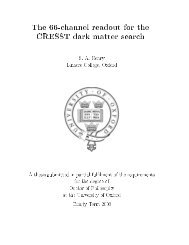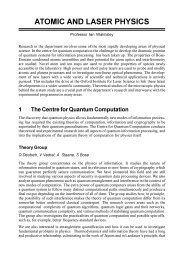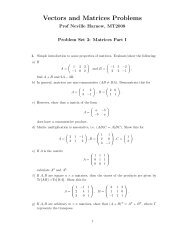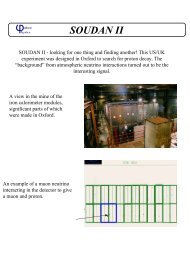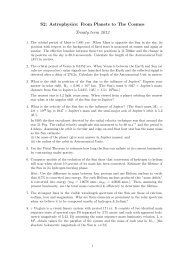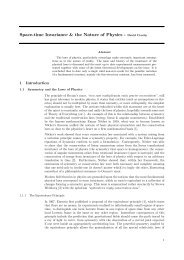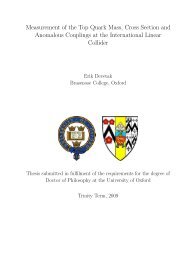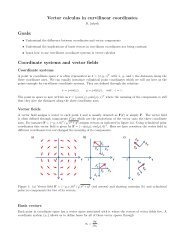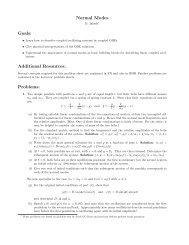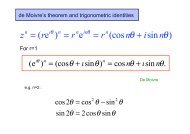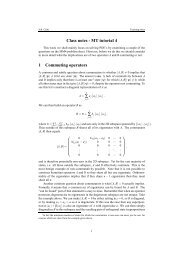You also want an ePaper? Increase the reach of your titles
YUMPU automatically turns print PDFs into web optimized ePapers that Google loves.
Safety Features in a PWR<br />
• The control rods can be lowered fully in the case <strong>of</strong> an emergency<br />
• Should the pressure drop in the primary loop and the <strong>water</strong> start to<br />
boil, the creation <strong>of</strong> bubbles (voids) decreases the moderation and also<br />
the absorption. The effect on the moderation is the more significant<br />
and the chain reaction stops and the reactor is no longer critical<br />
• The moderation is also decreased if the core temperature rises, as<br />
this increases the Doppler broadening <strong>of</strong> the 238 U resonances, which<br />
decreases the resonance escape probability p<br />
• A loss-<strong>of</strong>-coolant accident (LOCA) in which the <strong>water</strong> in the<br />
primary loop is lost requires additional emergency cooling to be<br />
available. The outer containment vessel provides a final barrier and<br />
worked successfully in the Three Mile Island accident<br />
Power Output <strong>of</strong> Nuclear Reactor<br />
Reaction rate R = (Neutron Flux)×(Cross-section)×(Number <strong>of</strong> Nuclei)<br />
Flux φ = Neutrons m −2 s −1 Number <strong>of</strong> Nuclei = N<br />
Cross-section σ = effective area, unit is barn = 10 −28 m 2<br />
Example: Reactor core contains 10 4 kg <strong>of</strong> uranium enriched to 2%<br />
in 235 U. Cross-section for neutron induced fission <strong>of</strong> 235 U = 579 barns.<br />
Flux φ = 10 18 m −2 s −1 . Calculate the power output.<br />
Number <strong>of</strong> 235 U nuclei = 10 4 (1000/238)(6 ×10 23 )(0.02) = 5.0×10 26<br />
R = φσN = 10 18 ×579×10 −28 ×5.0×10 26 = 2.9×10 19 s −1<br />
Energy per fission = 200 MeV = 200×10 6 ×1.6×10 −19 = 3.2×10 −11 J<br />
So power output = 3.2×10 −11 ×2.9×10 19 = 0.93 GW th .<br />
10 4 kg U(2%) 5.0×10 26 × 3.2 ×10 −11 J = 1.6 × 10 16 J ≡ 0.5 GW th y<br />
Fast Breeder Reactors (FBR)<br />
Predicted fossil reserves<br />
~ 8.10 22 J<br />
Fission reactors (thermal neutron) ~ 4.10 21 J<br />
Fast breeder reactors (fast neutrons) ~ 2.10 23 J<br />
fast breeder reactors are possible long-term solution to world’s<br />
energy needs (~10 3 years) - ~50 times fission reactor energy reserve<br />
Fission reactors consume 235 U so < 1% uranium utilised<br />
Fast breeder reactors have small core <strong>of</strong> highly enriched fissile fuel<br />
with no moderator. Emitted fast neutrons convert surrounding 238 U<br />
to fissile 239 Pu quicker than fuel consumed by fast neutron induced<br />
fission in core.<br />
Basic reactions<br />
β − β − α<br />
n + 238 U 239 U 239 Np 239 Pu 235 U<br />
t 1/2<br />
=23.5m t 1/2<br />
=2.35d t 1/2<br />
=24,000y<br />
‘fertile’ ie<br />
spawns Pu<br />
‘fissile’ ie<br />
chain reaction




